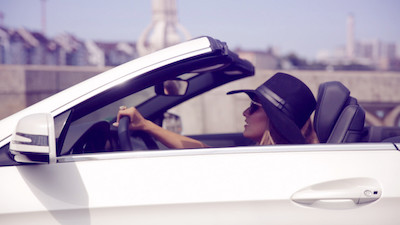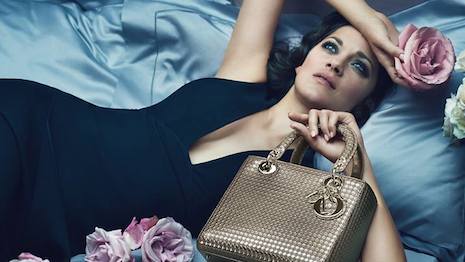On average, luxury brands’ value rose 10 percent this year, as a number of houses hit the reset button, according to Interbrand’s Top Best Global Brands 2016 list.
While some, including Hermès and Porsche, achieved double-digit percentage growth in their brand value, others such as Ralph Lauren, Tiffany & Co. and Burberry saw declines. This is a period of renewal for these brands, as they face periods of transition, whether through new business models or changing leadership.
"2016 marks a reset in luxury with challenges that all brands are engaging with," said Rebecca Robins, global director at Interbrand and co-author of the book "Meta-luxury."
"There's a clear divergence between businesses going through substantial transitions and others who have quietly been asserting sustainable growth," she said. "Hermès was one of the top growing brands of 2015 in Interbrand's Best Global Brands report and asserts another year of double-digit increase in brand value in 2016."
Interbrand’s rankings look at companies with an international presence and whose financial reporting is publicly available. Brand value is based on a combination of financial performance, the brand’s ability to influence consumer choice and the ability of the brand name to drive a premium price.
Ups and downs
According to Interbrand, the companies boasting the best performing brands are also the ones who have a clear strategy and are unafraid to set themselves apart from the crowd in their sector.
Overall, the 100 brands to make the list grew 4.5 percent, with a combined brand value of $1.796 trillion.
Tech giant Apple came in as the number one valued brand at $178 billion.
The only luxury brand to make the top 10 was Mercedes-Benz, whose value increased 18 percent to around $43.5 billion, placing it in ninth. BMW followed close behind at number 11 with a brand value of $41.5 billion.

Promotional image for She's Mercedes
Interbrand says that automakers are having to adapt to selling experiences rather than just selling cars.
Among hard luxury goods, Louis Vuitton earned the highest ranking, coming in 19th place with a brand value of $24 billion, an 8 percent increase. Hermès, at 34th, saw a 17 percent increase in its value, rising to $12.8 billion.
While other luxury brands including Audi, Porsche and Gucci saw their brand value rise, others saw their brand value fall this year. Ralph Lauren and Prada both lost 12 percent of its brand value, while Tiffany and Burberry saw a decrease of 9 percent.
Cartier saw a smaller dip of 2 percent, placing it at 62, while Moët & Chandon stayed the same.
Unsurprisingly, the same brands that struggled to achieve growth in the rankings have also seen a difficult financial year.

Image courtesy of Ralph Lauren
Both Ralph Lauren and Burberry have created reorganization plans aimed at spurring growth as their sales stalled.
"Burberry, Prada and Ralph Lauren have all been going through transitions in their businesses which have had an impact on the brand," Ms. Robins said. "How they act on those transitions will be crucial.
"Burberry is now going through another transition and has just pioneered a disruptive business model with its first 'see now, buy now' collection," she said.
"Tiffany and, to a lesser extent, Cartier are showing signs of how hard luxury has been affected. As new Cartier CEO, Cyrille Vigneron has arrived, there is a clear message of renewed focus around the brand."
Dior, with a brand value of $4.9 billion, and the $4 billion Tesla made the list for the first time, coming in at 89 and 100, respectively.
"Dior's rise is indicative of their transformational journey and their path to greater consistency and fluidity across fashion, fragrance and beauty," Ms. Robins said.
"They are finding a new balance between their legacy and reaching new generations," she said. "They have also been exploring new channels – as we have seen with WeChat and Lady Dior."

Dior's WeChat campaign
Value chain
Other reports have found that luxury houses are struggling to grow the value of their names.
France’s Louis Vuitton is ranked as the world’s most valuable luxury brand for the eleventh year running, according to the 2016 “BrandZ Top 10 Luxury Brands” report.
While there is strong appreciation for luxury brands, slowing economic growth has put constraints on consumer spending, but the comforts of displaying one’s affluence have returned since the global financial crisis of 2008. As a whole, the luxury category’s value declined by 5 percent from the year-ago period, resulting in a top 10 brand value of $99.7 billion (see story).
Millennials communicate their value systems through the products they support rather than traditional affiliations such as religion, making a company’s social initiatives and positions all the more important.
During a panel discussion at Fashion-Culture-Design June 9, an executive from Marvin Traub argued that a brand’s corporate social responsibility is one of the ways to create value for shareholders. While not all in agreement, the panelists discussed the ways in which a brand's values impact its bottom line (see story).
"As luxury businesses continue to evolve their growth strategies, ultimately everything begins and ends with driving brand value," Ms. Robins said. "Businesses need to consider how and where consumers experience the brand.
"Are platforms and partnerships aligned to long-term brand building that reinforces relevance and consistency? Is a brand's commitment to “doing good” understood?" she said. "Are brands focused on truly meaningful innovation that is aligned with a quest to do things better?
"It's a question of driving relevance and engagement."
{"ct":"kmHArmjhXis6V7PnLR2ZKaTZzo9WyK+CrelGd6wicX3As4xRdKL1BU8\/BRUOx1xkNKa1eW06DAJVeVUlZcOP85NTx7CtSmYeHA899k4k0Tm0ncm\/QB\/bo7SkciwJRAXBPpZcLiphPgje5ibAGCsm7\/9PZ3GGjHA\/jsckxoINZ82EGJzFCYXiUsBl6GXZjKw1rO06s0\/BrWHOwe6joLxkA1hjTMWT+nHyYwWJuOLGN8wbtY1r3PALeXxp1YXf0g7NWjEZbdofIkfOpQA67C58CY8gURbCDTPgniD0DJbpHtmzU993jEsVkWVkOJRkUyGLYJD2MkZC8jeuH3cUPJaTOiezWfzia7wg5jaYsUnwfrRajBWbCvrah85N4IzEff5YR4fkZIV9b0YMaPfD6zkCTPXxaGlzyWzPROUMDdDNphI61BS9ZOgJlT0bAF4DyeP7Z761yJzZnfi0EmxcXbxy0eyTAe9WogvzkWzhbkS0l6y18mWhuZKbzTAenCNOC2DgG5ff9dbMhvfkAy+20U9OS64MYkfaH90IMzkl1GXIKpSj\/erYADhCEJpIfTIue4Ks2cTQTDq7OwAtq0hOjZEg8caeZT1EyOExyaRLfZEgB6kl8rYaaHRnn4R23oZdsLOxag\/SDLAxKDbr3KYkr5XUgS\/ITBPaiTK6aMP85vopFoVsYK59Z\/h4cepZ7Q54KKUWtcIPF+izGoUTyCBy8ahmURxpXERw6NL1vjy6NJuVWszBX9TjoGwcDo+viIzfi3gzt0XRlYeWDn7\/NR1x7cvfoPUTARgA5KiZ81UNDM1raR8szxwT5rqbGoRlziD8oRn9K93YTu4JZ+DrSksmlDKojKmqcUCaqrCk1kugKTx8l\/nw9a\/hGeDvnX\/jBn6C0OsfPQTIe+A+WHFyW41xOyZ7TE9t3BhddxMUAVg1mlIafz7TefgBExSNwt8xqozYFz024HcTm6hCqHrvIuYCyMDzDAg8GNKuDjeyocU1lNL8Dz1KX0wiqBExmEobJSTlFsHyclbAdZTov6N0TYDr31YUQE3KMeVkkgMkabvod2v1qvNF+iZwED\/C8hdvINwKteNRXmpxsJeZFQLNH+Ex6jR5IS7wcb7\/mZr0j5q4xDX9b0DveZwvkZ+s\/UstCTrrAxnky+CM\/mL\/42h4odGZqzPE05SrOgpW5CpW\/llJ01+bO4Oh+6d8cKKy62+Db8Iv\/PJ0FXKWCCA4k1CytbjQ\/IARmfGvOWNwZD0uFDbE7qncWjEYh55\/yuqoALPOGSa+9fsCydE4wCqyEnR6773YLCXBuzbH90WntZvZyitjwJaEFAGAfQMZCVjgvp0FYQozEpQZK8M42pEsjw5LoMR04SDcywYUHIzks3j6LpoZBJ5o679OFudwqaYccmE0NtIDXmlclTWpP23Sc54hJBFcWbLVndcKfyHo\/pm6HiwBqzfMeDaxPQtON2YWim\/MegNQBVtaeqEAMDptztjx4yaeqAoWslgdNB5nSX3i0GMU\/iV6t6n54WG034RA\/fPCVFqXuXuWxuk\/SB9Erwu1vtDptHV6BNzjN89TSBlrWk5QmrwycLTCp2cPBEl4xUmTRPyD2rpAfuIm1HoPDm1S6oGR7w2qLpTQ387V4TscBv6p1NNQN6Y7rqCkUl7iMgYIXw4G2rS2hNeSC+ZwfZftS+iB9F6fehcCDPhSDE53yOjA+r5vtT4Qt2CYFq0ctN5Pa\/D5RXF7NCV7y4PWJtTLjEp0oScC9G+tmpRsUFVS87I274S53rju\/Zbg+Nym3rJNIXeBekhYOJuOWO1zWwt9o1vMhCJYqgIr09UNriggveBFsP95UVPa5I4s15YwLJllOG3RRxoBjcOXGvADCIGoI\/gXZE5Gt1ieHvMK9\/ebs+rlho9k7I0spQaz\/j44Br5tzCZ1ARsBr6zBBDkUPeNbZHvAPU4MI6NCdNmbHPFUn+oPkVi4xv7CvNgx7FDd3Vc7+OE5ZsiOCQx3IsFy9UDGj2cFbvLwMktuhomuSsoJjdMHsQ5IXgqy2EJFHy1mrWJYhfv7KxKVj69muxn87gNpqkI5X1LRrIundJaKS0E1h+nN4hXDF3Ii3HVTvDmdITiEDdcX32sQFNTThwWpCqn6qoUp\/Bwo5TSAUrsx3NkdyDDY0hMmVozsEeWHwGimqG+SbnuK5vGiwy\/txdXLRpya0GVcG9gTdEoXYADqW0pKctNb189dAp4K8A4Wj6x8DEa\/QETNAGiJreEboOPVKpa\/bHC2cEXDxXmgK7CvKvv5jWawxSE4o0y9x4BNQv9Vl+3hkNeqBV8KuGfq++8bdm7XA5xOUbIx6zJrJX0m\/sWybARQ2XyfmTVeRYvqP0bxT5sGsldZ1o7b4GmDA5aYs3nKV9DbDYa6g4ylpgkl\/9rVIl2GZLgvTPCO6XdnpAJ2iVVpP7uv9LzR7T6m+oh7KZ\/qbIjPVcqpxWvg9465uju+K5nqIbBMz3GBw1Gp97bnEUtAyCzUdAz6BNLGWMKe1k9fwxgJATLEFWJmBz1FQNMhdXEXr2RlO6oTEZGcstJK3bUtMn2\/XXTCvmTyVKJDX4Q5aHWws0fRG4lJvPzTfBZ2lLKEcjyq+J1lDUO+wi7aAf7VEp7Q3nAYsFUhzP8MFW\/\/OvO2\/8N596JRMT52xSXPWSuP7rHMJPjE7cjWfhp+2HNHZRo0PSh1IN\/97ffIxiYai49HbCZF4sX35YPNpN6jYokrqq4fJ9+5RramZtSZKhd71s70YqozwX57aITxaxqMO8y3W28Peks\/GJtGXajuMykgkwJYzzxzxEnl\/BDA4p0cNo9XTtJ6bXUC25wLIPplUuy2XI7IyTszrkGvvUY\/N9TiM0Hyr33062Hv8U0\/SNMatV34HaFs77L\/2UrPJCkUn78G0mKMAwJH0Btfb596SH4LHtdODdyGnJCmuQHZxQHyo0r3EmzVFIfQDIOGR6voUOvE8LmUF24MSeM64WoWo+CC1fRGM5Vo6kqJ0nFL1AoR\/EjP4V3j5wpDhel7TBgH3RkrPp7fuDnOzZmJ613c8PSs6Vn3\/pbV3JNAQRdt1LRrDur0xCPQzOH\/rValjocO2mk67lCf8nEJjotdNQnJF6g0fiojeHS7lQmbT9qMZlU93pOB65+q1tVHGkUWZpgtw5S8ux32dQ71mWau6Z33P1P1KbqWd3XwAubVuRog6I7k9ZETgqeSmQkF8sSgmHLXMLZVjIiTVgHXgwXMpU9g2lsfM4Prc8pkeRf1JNUTyKDcKsEVB0gTYQ+YELgkOjk5CpRPSlvfOE00CJxJ2d+ekXGgAUQxaXk0CMqz9w9X+kLZ2LMwCksA7kR2UkGS+OQ4lMpS3ILClzVdbRbvMPncX\/GDLx3dm7KfcM0EMIttofuRMs1HRjoEETERxgw24g34SRo2szvEuCii1DV01AkTLIh6tHAHqagKgCoQ5KKIZQmIHsQdLTY0G8lNbp24YlN8L+L2kR\/Cd24VijqKCcejXxg\/XofM5Sqa5Go44mBkAqhv5Lr3obVxZd6AB0A8hMdUGMUxM7M5kDq6ALD54tV0dg8TOPA6Wwq1kcmZ7QbzOrF+B\/G7vxz9AIKvRqT069M0LEP\/ZuGD8pNV9afIx+tOl1I6GMSfFd\/9utqWgrrT36+g1dOGzQVUOgqkw9H+HJGcsog7ilVPpRuft\/w4ubkfA5Bx48yzsfKlSQCFiZNSvBVvcsQ6mXcGVQqZgpVOPNj06nsoLvszhGIZOtnX94udSMRpPcm0XYD1FeArV1pXMVzdz3twVhQ81qlKzTZaqvqlb4j4w4DqH8TK5IALr0OBv7kF2H27EiqoQcMBY9YA04Sil00cvuR21eW3MYZloAgDeIGZzdrxZl5AcCRg+ufH8y\/tksZSrXM52o7l9gcjahyRlV7Cal0hYEXAk0RN55p\/F7\/IkKeEaPWBo2yN4lZmM2FUmOKKszZAsD\/aTriujfsG85mYZ4o0gpob6mFpcHAtD3yIpu6dD\/1evqA9YTLnpT6\/1U7D2aiRjgCwPhfy3XLpvphEXJk3IlqEDM1aPI91EstWhOE0eXZvGudyJS7dIS8TDvicPcDKoMRHgXxd4dnjlhWTNxe5PHtXH5VddSNQ5QfjBu4bikKOO5KU5tRZhzPGePHQUEoTCzn0LdNl6LCNwe1M3pIR\/N3ZATYBwws5IieEoeVHUUFZ+v2w06x2c6SgCZFECNRrRJ3ZOqgmaOIvjKaOFO6t\/XI9fCfqLa4kYgE\/MDiR9Bpi9L\/SuIsQmUtBpzwQaZ4uZuD63Iaq+A6T0OcDhm5n2XY+0pOJAMtmilG4fGj9Fuo40hDGvRuKfghXwvsapfcAKd\/ZjMvDa1hFgXwODA41DYSetrx+2Ap73Shno7Ap90U6VHQxFSfXypJrNYp1JgnC9YaIReMwcCWcSSdxCvS1VokBLxvVEAVkLUgabaI4KTNxG6kWf3U88SKO0Ac0abkjF2K0zUJOnaCV3DetPQniZ7hLjhVMRbPH+\/Kp9ID6JFgriIEvJD0fA\/nvXpQG7cY3cPSvUKezhCeFUa4zPqSdfdK7nGwNLZr1DY1ut2V4MlvDeJFHHvZZgwHi7\/8pDF9wyXJUnMeVRHEpNGMldptmaRuJ5\/tAhHsvhleyO5ERpRyUSinFvI5LgddLm\/okPmpddHUBpUjuNoFfE18FwBFZE9AFmM9nY8GvHuE33qk+P8oS1YLBXwAlgaTKl+Dst\/UJeU2ZC\/a9E5a2YGkpC84uUcX5m8OOBEW6eCzHvSH7uF96DMDVtjq4q9kaTwnpsPrsL+1d0A6eFBfxWdsFIy9Na\/Z5cjWieL5yZHxDIJj5aNeQXsjvPIEPXANshDiC4f1b0uyZQ88PYMDIhUAJm1+UmoZeUOAZC7tXWcNPlTE+W7gJoa5E4k8Ps6QErxAydlYRwfC0mwmya7q\/ikrFONvDIh5Xb7TuOCCllWmPAF2tv0qY8YM2owN1iwjIwYH2NhtyTzb5Jr1CE4HW5IkKeedSBrODSP7ECs5ZJm6uAdBigNQIOWCpB7Pd5sMKG7O1Me3LKdnCDMSohUos1PJwN0Dml68RAzb5xTMLPg3z8Jl\/Cc0oBRfva8yHf8VJXIKPgRaxK9dyRozYixIRUlwWGMLVS6mtaP+EEstSYf+nm8lL0W+N8PO9KnVePkGL1LUHMsVd03AA4KdWcvRPl2bz1AdTNcD+YuTDXoWJKMwlXmbX6FBxdkivNz63R9P+IK9NiZryzwCO\/zCt+CebJpr5O6TSG3OFxxO5Zr+g9WDYYc+O86a1kBlZ14Y+H1D\/90CvowABDPj6MC6wBhi2ifpB67h+vAjjDxpDLKT0PABHmNdDSUvbQLi8Ca8tWCyqtCy1nvQA3nsIPIFIl15L0OEHNWoInj8aExMN008+FOylvoAPRb6sQ72T2eGE8c0H1LTDHn\/N6qC1w8ug3Dwf+3T35+eYrpVnNjGnx0W2hNXYSpjaa67QRCoqjv0t8rpRSMMahgbylwJgX17I1+hKk5Uuo4Z\/XhAU1GEF+8+38hTELCEfITazYqyN9SuOBCqNb55YSOrsQ4hcfKolT3v4NaHNa+J+i56gDWYE\/IT6CzZC2Xusmp3umCv+uUvnXJ\/NowXfB\/sIISbCGjK006rJgKYP5wBlY0aj4aORJTujnfMJR+MrtpZbQs6cnUBWG4JG3Fe+2ohiVPAk41+iDMhzagmeqAEahznFkM+8pCA+O7R1ZcRwypMqnJIhOhSLJmrMsUg\/MBfG0Vhbpd4zMugG\/bA1\/+DOXSsk3oCZCVj0d4VDWx4kAXoEqebneTBXhwT2+yn1Ifyax3CIGCSSiPZSyTMs75eq4s4wMsiylV7VzDRpLRNflT3\/tIex3IzEQG2ne0h0ChRVnfl2KOYeZg87b64l4HRhd9amJjMojcDAprSuYUPEL+uaS7KAgnjZOooEsZqDZDAK1frQr+kU7wKEu3swzPIVl7vMeqK5kAJ6BrN+WI+Z5Cpq1wihbGN6FOeLAU7U40Yh2l5UdXUkKvCNcr1XvafXVYg4fJ4dyQKpoKwOxMtqtTsd4B2xrRPNHjuyEvImH8SpIBt\/mB6G9d6\/F4540jPh\/UaDQENGH6GEVmSRCsEv7e3nCTbU2LEP2n82Llg1f9BsCZepHhVerSZPt0QzH8gxDyBSoNHkEj3foU0cCc3VTqhDisria16ekcLIKnxTOJCIFj4ugG5dsNXEnO6R1f0TKR5Lmlcq0RyrY0PU1JgBiPONNdyNfRSj\/rED6v7t7EO6v9gq7DwgdPaPjzuHL3onGTtTDXLCH4QOwu1OxrS0yL1udugSir5NtqTVVCjQkw7jZOpwnuGHC5nqBXsUzj+l2A0OqkLPlzdnQPuYT7VZj11+P\/aTQewh33a3A2nLf7CBszHfEOvcdm1zOmGw4kIBM8Gc76XACsrVCQ2eVF8\/gomfg\/gLJMcEUjGdW2BTgldlST6JJp3Cr7vuQa5FWmT5vdaOt3d8AmI\/C3UknePtbAjVWHsR8mKS2DN\/cIUvhhBCfijP26xQ\/L4S\/jd9CULlxesGFPUZpZ05yqt6uRQBAT15JHEix5zJvi\/TFmapSBMUFWdcVzW84ffr+FoRuVwjqRVVRQwgP0JJGp89JNefL50Q32nTso3tqjE16DXrwfOSBmEy2X18zafde0Z6ABUOS1gyZMnnrkYg2Qi34+wZObil8GsjRA2V3WqxsMQ2eyMXwDkNqf4Sv3Nym1iZakoRvCKdwSfSOVBtSK6bkMFLTZIJI6JolEHVUrZJNbT9X5FLhlb7PvG3OqHCp+R08TT3vw5EBEZmIF9lVElph\/U60Nr5ctOITquBxKE0JVCVrxBD\/blmYC\/HTu48GgEmg3xDpRIr5b7xLzzV7RMJB1hsiSyN+GWVOVBAjN7LOFJfRgL+1Bk7fw5hfLKcklb3fXLtLNtfT\/NVMAUMF+Zv042JYysVuhE+Sud3J1r38u20HrnWiHG2FmGXIr3ZP7fGdoWNDghRsEZb12\/UxMlw5QPHMQ8hw2AgbralD4h50tqiPnG7y\/l6PLcI+Psw\/2nuI0BZckquiubJIMLSmWh+yUH4+JWRwnJ4l9x7OClbst3KTscMrTVoFh\/Z4kEEsjG50fDxLYuGAagaM6lxR7d+0LcCitfhGZIXkbaj8KkrU\/isO8cBCcZDp3PpadECfgWp6AhnQoPBJnlNTOxp3ms5DbUKO72l6K9bDB6AOZ0I4Rm1OxvuOGDYzOtLFCq0PtofwctmF7MAdJ2dbfGnBLhcJ4SlKl1lbs\/SqGVad6jSiZZVKlKNJ9nmpmXI7vGTpabb6Pd4y2H+BeIeZN4AxSl1Dz42iD0A76\/YzXnhKDd65jsMBwXmSAe0FIPjrXuaXxR5FrcOfgQ2U08YEj+v6yAGdxVNA5CP74d4f8pFDdkZa7N2NFksqTMZxEsiBsSXWpzPPhIdzKRFtFfWGSL+Gk7fMF\/tVYpLhOqlm+YIZ\/Zl\/yHOYY7UNcGjQPnsldsoys75Hp03KSeQrQJCdjvQIXeYE4VR7HEQCd1+9u6OeaUHBpCtx6o07OoGd46qrQdUWIXdXHjCdXp0ZdtUYRAgyhQxlo+08nLIJC3KgspavAhgfVx2bmj87DPkcU2XeycSc31WF4jCCaweQek8YThfl1kHTiB7lz2DCuIw4JFHW7Zz53e3AqJD0duS6M9cDLT6jGxGD3n93GgqdfIhgyOspW4BZfIvoxUOskbxitN5OQs\/k5SuGynwJIemi5Ne5DFK9+2D6NvWzKelGX2G7rN8pwQG5Cu77jtQG3AEWaitiIU8HX+OtMWhbKXMufVsa\/F3S7+qq9TLDBSvslAtQtd\/gNR8bgk3jku8BK5khYp\/BptV+uuJDkg6mK322VCzmHttXMX9lZIR5CBuu8ZmDmVOC\/S6E\/S7Rz9RFieL4SBuARRxvqhisJ4trrx24zECt4H1EOjxj2DRrgT2H0nYi4Ex\/7ld66ikbgW1HtfRt6RfT74o\/SW8OomQ9Eezcr5l9KJgnIqU8Nbi1Jq50fsIWqnMtdF+ppmNfu4RCJ2JxSclNblq9cuflq41dsO9TG2HIkZeDYbW4kK04hg4YH+1TV9OWequGis7LPvWoXvUuWZjTYMvq8qTJQYCMZcx7t5JlpC8gNgmTZJ\/f36nC+2mJsUfJO2oMM0XL1r1Rwp6DQd\/GnXRzY+wyZY6HQp52nbSEAAHDClqqWYck3tSTbtuo4TWraC+r5b5AiRx808nAPUQttLPOEM5fAE0XZg+x1zRPpx4TWgkXl6c5rKGhOsxXBLXUnGxAfkFYuA2CqrVk1b2+vC8EeK8icK2GqyXF0tcfA05h6v6fSaXh5amjdisdtXt3+BW0gsRtwphwfbUBBTC8LNJ4+iDrkC81M6t5PCuZFtvVJJowNDg6tBPHIyl36TKLCRINablMBZpA6ZLEPtG690+xpX\/Z\/oP38Z1CLUYC8DDDnVH37j2hFszSA+ri\/tsZf\/fQ6qbVXlxUlQ04q2tTRE2jyY0h7UjbWoqLtmW2kg8BkslqDGZax9pvFSl+b6aBC936XobheXrBJzE90JCbTuxp0FFU7ytT+BeLcIMy82fazcac5zeJF7KWQaRAvC+0I3WT1G\/AuYaWFOHvgBuOnvXOVxtlTu3VZxymMlh55MOtWpn0S1YrMlIsI7qeEQw7Zabu38RdKOR4w5P9MkgFgxpnf1LmO+V\/FxqPaXNJY\/rHmPjc\/haeM0zVnB9QvpONkdnBiMqtVYHgDxkpeW+UIlCktj4K0oH2w7PMYBCbRzHKCJFJt71\/LHsGRKWWUxYU+BiDFQ2UX6+1fnUtpnTSD40oeh\/+57MnSNMUl+cvR81jXFP3naazm6FhaLiG3B38eFDO131aUBdJuV1CORVmrxJZQvirnHVtsYT+O1BOnnZOnnyW+VxdbW0HvJQAavS5qLEHtVtjwwTKNbCywsYyND7aHmnqvED0+epIPhRvC9LE6eKfEOFk7SiFn\/ooHbPlzzR3yV2vw2IsvL1cM4zwPXMSzroJg8qwFDr\/sDPDMpbotaIDcul\/iZIMcd60K\/vc+cGj5hca\/j0WMxBaekYjnOM6uSXQkkoaFHFzLaVZBAvwJ5sb1oK3YjrBxWLjRQNEu1q1oKeCLAzkKke+qmU+mNJUqvkv5t4\/wFcIojoGZQTdcOnH2ZWHlhFwnzI4mVNOxdxn83GOJkqBYH9LW\/gaBHgqX2Kxmou76aUNx92jky8mUluRAQJjfHkSDH0OLPPqww2R2TuOm1Qxw\/FnQYFeBNn+A1grt0mccS9XVfTpl2SjMLkVXj+lHmeGxpHrvRACeuWKSgiQbsFp5ysmYktlPDfifD9Bvf1WyOhY7sD62KeCzFBEsaLDldmff09p1LS049PcTTAGDaMajvw3Le0DPuiEw2kKQwVP20jLSbM8VpNi+rHkhODEIsvzIjgXGUoiV3OmEgHmIfIZoe6HQ7kH2O6cnMv1BSF5k7H2bn3qTZkSOHG\/A6hBAt3NXwG2M9HcH3wwYg4miL7NNBflZu4ETDqiN5nE0ambMj9nJggB5PysbH5M6f\/cwmt1ATBIGpXC0SRstdAg1eIrudTGigmBXhMPjrFlCFeHS9w59rN332z5Fkr\/zHFLYLFRNk369Pc8t+ZQK5G4e2CGOra8W1wkl\/PckNqvxUvx1xHf2EyD0x1ZnPx3Mie4+VaTa13QEUom3JsRDVmIaC8fg3vDfSauTqfzo+DsRHocFA5CKEFUTX28Txae0kwz3pe5VCdqTD\/ePQpypDj\/E6Pw04M\/DDRSQxb5k2cIE7H8Do+m+Z4Ff6sqmZrmNTedfjv+A+PSeJLQa5aU+QwMn1Ro5Zf5hJcMywP9YtVcYGtawT3ErU1UR0pp\/5mNPe0Y1CtOahOU7JcasdVGIUPBq8FWoVyxUNw34LtBMROFSTjiinjKDTueqZpxNFdaSuWKiigSokfaNuF7iD3K5EiGwchYLTLcvcF8xtB8NFMtKPjQMVfIykhIMquIqOWHWOGH1uBK372PT+sVzTkW4o1NeBiiU1jCxnltM7IwP+ZuwhzkVJhURZGCH\/JDxfg4gzrVMZqkA2K+pEA\/qfdk85XMQF16brOxalewrqNj\/Xo5qxZlcqoP2iDacV6tHfGlPKMkgGkIRLCpYEgxtAMYugP6fQx8BPxTmKFtHt3eBEJp4GkZECpbTnjj3rHAJLUg1an+K3aGlAY3AT6jmL2bIZNPXeZj+3aj2rCiifX8G+euRyjqzgay+Ny6FqgXrZKwP8g","iv":"8a131cf7d91e47d6100dc7984cb5f657","s":"438a416c818c9802"}

 Marion Cotillard for Lady Dior
Marion Cotillard for Lady Dior